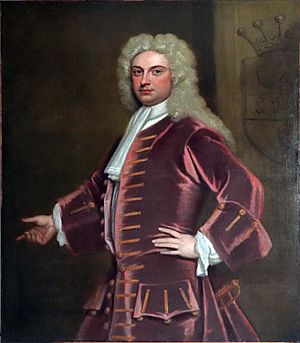William Coventry, 5th Earl of Coventry facts for kids
William Coventry, 5th Earl of Coventry (born around 1676 – died March 18, 1751) was an important British politician. He was a member of the Whig Party, which was one of the main political groups in Britain at the time. William Coventry served in the House of Commons, which is like one part of today's Parliament, from 1708 to 1719. He lived in London and later at a place called Croome Court in Worcestershire.
Early Life and Family
William Coventry was the son of Walter Coventry and his wife Anne. He was born around 1676. When his father passed away in 1692, William took over the family's responsibilities. He went to Pembroke College, Cambridge when he was 16 years old, starting his studies there in 1693. His family had connections to other important people, including his grandfather, who was the younger brother of Thomas Coventry, 1st Baron Coventry.
His Time as a Politician
William Coventry started his political career by becoming a Member of Parliament (MP) for a town called Bridport. He was elected without anyone running against him in the 1708 election.
- Voting on Important Issues
- In 1709, he voted to allow a group of people called Palatines to become British citizens.
- In 1710, he voted to impeach Dr. Sacheverell, a religious leader who was accused of speaking against the government.
- He was re-elected for Bridport in 1710 and continued to vote on key issues.
- In 1711, he voted on a change to a bill about the South Sea Company, which was a big trading company.
- He also voted for a motion that meant Britain should not make peace with France until Spain was dealt with.
- In 1713, he voted against a bill that would have affected trade with France.
- He was re-elected again in 1713 and voted against removing a writer named Richard Steele from Parliament.
- Later Years in the House of Commons
William Coventry was elected as an MP for Bridport one more time in 1715. During this time, he generally supported the government's decisions. He hoped to get a job as a clerk in Parliament, but it didn't work out. However, he did get other important roles. By 1717, he became the Keeper of Frisham in the New Forest. Later that year, he was appointed as a Joint Clerk Comptroller of the Board of Green Cloth. This role involved managing the royal household's expenses. In December 1717, he gave a speech supporting a motion to keep things stable. In 1719, he even traveled with the King to Hanover.
- Moving to the House of Lords
Things changed for William Coventry on October 27, 1719. His second cousin, Gilbert Coventry, who was the 4th Earl of Coventry, passed away without a son to inherit his title. This meant that William Coventry unexpectedly became the 5th Earl of Coventry. Because he now had this noble title, he had to leave his seat in the House of Commons and join the House of Lords. In the House of Lords, he often disagreed with the government and signed many protests.
- New Responsibilities
After becoming an Earl, William Coventry was appointed to the Privy Council on March 22, 1720. This was a group of important advisors to the King. In the same year, he also became the Lord Lieutenant of Worcestershire, which meant he was the King's main representative in that county.
Later Life and Family
In 1720, Lord Coventry married Elizabeth Allen. He continued to be involved in public life, becoming the High Steward of Bridport in 1727.
Lady Coventry passed away in 1738. William Coventry lived for another thirteen years after her. He died in March 1751. He had three sons. His oldest son, Thomas Henry Coventry, died before him. So, his second son, George, became the 6th Earl of Coventry. George made many changes and improvements to their family home, Croome Court. William's third son, John Bulkeley Coventry, later became an MP for Worcestershire.


